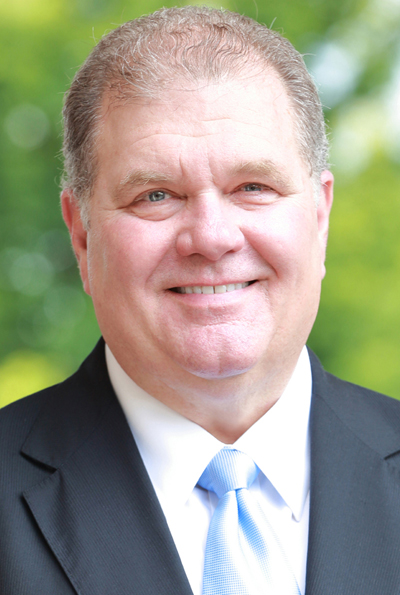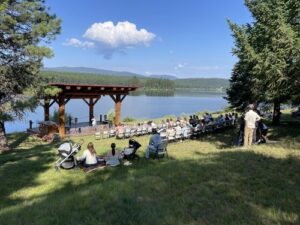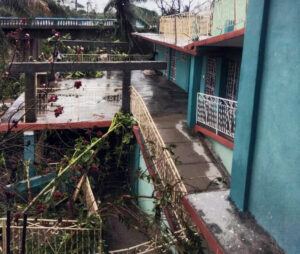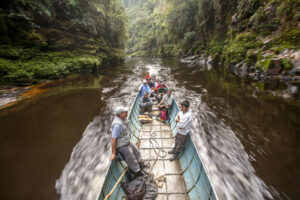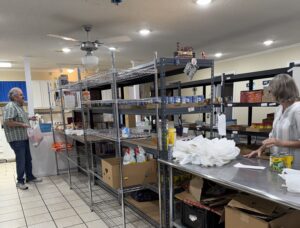
Editor’s note: October is Cooperative Program Emphasis Month in the Southern Baptist Convention.
WHITEFISH, Mont. (BP) – At the very moment pastor Curt Sparkman spread his arms preaching a sermon at Flathead Lake in northwest Montana, a bald eagle stretched its wings overhead, Sparkman told Baptist Press.
Earlier, he and executive pastor Jason Palmer slammed their brakes to avoid hitting a black bear while driving a trailer the two hours from Missoula to Whitefish. En route to the lake to preach his first sermon, Sparkman said, he had driven less than two minutes from home before “right in the middle of the road is a moose.”
Montana’s vast open landscape and plentiful wildlife are part of the draw for Whitefish’s year-round and seasonal residents, said Sparkman, who officially launched Goodwater Church Oct. 5 in the center of town at the Performing Arts Center.

But the beauty is also a challenge to spreading the Gospel, he said, as many worship the creation instead of the Creator in the state where experts say some 85-90 percent of the state’s 1.1 million people are unsaved.
“It’s what our enemy loves to do, take something that God has created and that is intended to point us to worship of the Creator and turn it into an idol that becomes the object of worship,” Sparkman said. “Creation is one of the things, at least in our part of Montana, that people are looking to. So being able to have services out in the middle of where you’re looking at a lake, and people are bringing their dogs, and one lady’s painting, and you’re getting a chance to talk about the Gospel and say this creation … is evidence of a greater love, our Creator. The lake was a unique way for us to do that.”
The Cooperative Program, along with the Annie Armstrong Easter Offering, is a key Southern Baptist funding avenue for North American church planting, especially in states like Montana where there are only 120 Southern Baptist churches statewide. Nationwide, 22.79 percent of Cooperative Program income supports missions through the North American Mission Board (NAMB).
Steve Fowler is the only paid associational mission strategist in the state, with his salary paid by Emmanuel Baptist Church in Billings. As the church’s associational pastor, Fowler serves pastors and church planters across the state, and is also interim co-executive director of the Montana Southern Baptist Convention (MTSBC), along with Greg Payton.
“The Cooperative Program is vitally important to church planting in Montana,” Fowler told Baptist Press. “The funding helps us recruit planters and helps us fund plants that we desperately need to impact lostness in our state. It also gives us a way to be involved in sharing Jesus around the world from Montana.”
Fowler is working to revive MTSBC’s associations, which are structured to resource and help strengthen and plant churches, and engage them in missions. Largely, associations are led by moderators, who serve in volunteer capacities.
Fowler restarted the Yellowstone Association serving southcentral Montana, the Triangle Association based in Great Falls, the Highline Association of about seven churches in northeast Montana, and the Treasure State Baptist Association serving Billings, Butte and Helena. Two former associations, the Big Sky and Glacier, are now addressed as regions, serving the western and eastern regions of the state.
Goodwater Church, in the Glacier Region, benefits from cooperative relationships and partnerships with eight churches, both within and outside the state, Sparkman said. He intends to give at least 6 percent of his unspecified receipts to the Cooperative Program, and to cooperate with the MTSBC in undergirding and supporting other church planters.
“The piece of the Cooperative Program I have the most interaction with is Send Network,” Sparkman said. “They give a percentage of what we need in order to function financially, so that’s helpful. They help build connections for us with other churches.”
He appreciates Send Network’s perception and model that churches plant churches.
“We always talk about it’s not just a network, it’s not just a convention, it’s specific churches that plant churches,” Sparkman said. “And then there are elements of support and training. There are times even within the state that through the Cooperative Program, they set up trainings for us to make sure we’re doing the things we need to do. We’re taken care of.”
Church planting team leader Dave Howeth, funded to work in Montana by NAMB, is operating with hopes of reducing lostness by at least 1 percent statewide within the next decade, which would amount to roughly 8,500-9,000 souls.
Montana has benefitted from five NAMB-funded church planters this year, Howeth said, with an additional six planters expected to be on board for 2026, four of them sent by Montana churches.
That’s “an all-time high,” Howeth said. “We’re excited about that.”
Church planters engage Montanans by building relationships and serving the community, Howeth said, before opening a church.
“That’s the way you plant the church, versus pulling into town and trying to start a worship service and expecting people to come,” he said. “And it might be a little slower, but the roots are going to go deeper.”
That’s how Sparkman planted Goodwater Church. He engaged the community for more than a year with such outreaches as organizing a group to paint the Whitefish football stadium, and volunteered at a sporting event the day before his official launch.
About 150 worshipers attended the launch, including members of partnership churches, and attendance has averaged about 100 each Sunday since then.
Even the summer worship services at the lake helped build community before the launch, Sparkman said, attracting people like a painter and children with dogs, who were more keen on gathering at the lake than entering a church building.
“She would be looking at the landscape behind me and listening, but painting while the service was going on,” Sparkman said of the painter. “And then afterwards, we could have a conversation about what was preached in the passage and she had retained stuff and she was processing it.”






